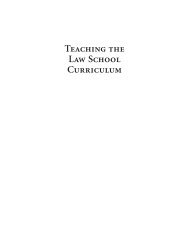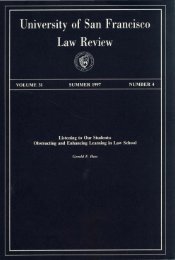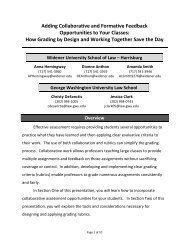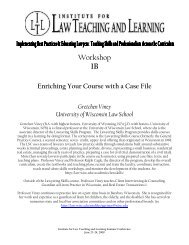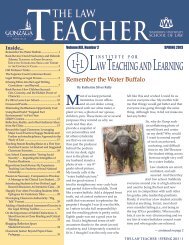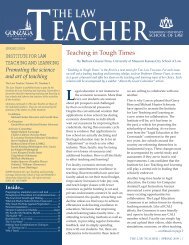Seven Principles for Good Practice in Legal Education: History and ...
Seven Principles for Good Practice in Legal Education: History and ...
Seven Principles for Good Practice in Legal Education: History and ...
You also want an ePaper? Increase the reach of your titles
YUMPU automatically turns print PDFs into web optimized ePapers that Google loves.
Association of<br />
American Law Schools<br />
Journal of<br />
<strong>Legal</strong> <strong>Education</strong><br />
GENERAL ARTICLES<br />
Paul D. Carr<strong>in</strong>gton<br />
Michael A Olivas<br />
Kenneth G. Dau-Schmidt <strong>and</strong> Kaushik Mukhopadhaya<br />
SEVEN PRINCIPLES FOR GOOD PRACTICE IN LEGAL EDUCATION<br />
Gerald F. Hess<br />
Susan B. Apel<br />
David Dom<strong>in</strong>guez<br />
Terri LeClercq<br />
R. Lawrence Dessem<br />
Okianer Christian Dark<br />
Paula Lustbader<br />
Pr<strong>in</strong>ted <strong>and</strong> distributed to law teachers as a public seIVice<br />
by West Group <strong>and</strong> Foundation Press<br />
Volume 49 September 1999 Number 3
General Articles<br />
Contents<br />
Teach<strong>in</strong>g Civil Procedure: A Retrospective View<br />
by Paul D. Carr<strong>in</strong>gton 311<br />
Pay<strong>in</strong>g <strong>for</strong> a Law Degree: Trends <strong>in</strong> Student Borrow<strong>in</strong>g <strong>and</strong><br />
the Ability to Repay Debt<br />
by Michael A Olivas 333<br />
The Fruits ofOur Labors: An Empirical Study ofthe<br />
Distribution ofIncome <strong>and</strong>Job Satisfaction Across the<br />
<strong>Legal</strong> Profession<br />
by Kenneth G. Dau-Schmidt <strong>and</strong><br />
Kaushik Mukhopadhaya 342<br />
<strong>Seven</strong> <strong>Pr<strong>in</strong>ciples</strong> <strong>for</strong> <strong>Good</strong> <strong>Practice</strong> <strong>in</strong> <strong>Legal</strong> <strong>Education</strong><br />
<strong>History</strong> <strong>and</strong> Overview<br />
by Gerald F. Hess 367<br />
Pr<strong>in</strong>ciple 1: <strong>Good</strong> <strong>Practice</strong> Encourages<br />
Student-Faculty Contact<br />
by Susan B. Apel 371<br />
Pr<strong>in</strong>ciple 2: <strong>Good</strong> <strong>Practice</strong> Encourages Cooperation<br />
Among Students<br />
by David Dom<strong>in</strong>guez 386<br />
Pr<strong>in</strong>ciple 3: <strong>Good</strong> <strong>Practice</strong> Encourages Active Learn<strong>in</strong>g<br />
by Gerald F. Hess 401<br />
Pr<strong>in</strong>ciple 4: <strong>Good</strong> <strong>Practice</strong> Gives Prompt Feedback<br />
by Terri LeOercq 418<br />
Pr<strong>in</strong>ciple 5: <strong>Good</strong> <strong>Practice</strong> Emphasizes Time on Task<br />
by R Lawrence Dessem 430<br />
Pr<strong>in</strong>ciple 6: <strong>Good</strong> <strong>Practice</strong> Communicates High<br />
Expectations<br />
by Olcianer Christian Dark 441<br />
Pr<strong>in</strong>ciple 7: <strong>Good</strong> <strong>Practice</strong> Respects Diverse Talents <strong>and</strong><br />
Ways ofLearn<strong>in</strong>g<br />
by Paula Lustbader 448<br />
Conclusion: Adapt<strong>in</strong>g the <strong>Seven</strong> <strong>Pr<strong>in</strong>ciples</strong> to<br />
<strong>Legal</strong> <strong>Education</strong><br />
by Paula Lustbader 459<br />
Faculty Inventories 462
<strong>Seven</strong> <strong>Pr<strong>in</strong>ciples</strong> <strong>for</strong> Gooa <strong>Practice</strong><br />
<strong>in</strong> <strong>Legal</strong> <strong>Education</strong><br />
<strong>History</strong> <strong>and</strong> Overview<br />
Gerald F. Hess<br />
367<br />
The seven pr<strong>in</strong>ciples ofgood practice <strong>in</strong> legal education are modeled on<br />
seven pr<strong>in</strong>ciples of good practice <strong>in</strong> undergraduate education. The undergraduate<br />
pr<strong>in</strong>ciples were derived from decades ofresearch on teach<strong>in</strong>g <strong>and</strong><br />
learn<strong>in</strong>g <strong>in</strong> college. This issue of the Journal of<strong>Legal</strong> <strong>Education</strong> applies the<br />
pr<strong>in</strong>ciples to legal education, explores their implications, <strong>and</strong> describes practical<br />
methods to implement them <strong>in</strong> the law school classroom. The pr<strong>in</strong>ciples<br />
assert that good practice <strong>in</strong> legal education<br />
• encourages student-faculty contact<br />
• encourages cooperation among students<br />
• encourages active learn<strong>in</strong>g<br />
• gives promptfeedback<br />
• emphasizes time on task<br />
• communicates high expectations<br />
• respects diverse talents <strong>and</strong> ways oflearn<strong>in</strong>g<br />
Development of <strong>Seven</strong> <strong>Pr<strong>in</strong>ciples</strong> of <strong>Good</strong> <strong>Practice</strong><br />
<strong>in</strong> Undergraduate <strong>Education</strong><br />
Dur<strong>in</strong>gthe early 1980s, concern about the quality of<strong>in</strong>struction<strong>in</strong> colleges<br />
<strong>and</strong> universities gave rise to a series ofevents that culm<strong>in</strong>ated <strong>in</strong> the developmentofseven<br />
pr<strong>in</strong>ciples<strong>for</strong> good practice <strong>in</strong> undergraduate education. In the<br />
mid-1980s the American Association of Higher <strong>Education</strong> published several<br />
reports <strong>and</strong> sponsored a series ofconferences on the improvement ofundergraduate<br />
education. Two of the AAHE board members, Zelda Gamson <strong>and</strong><br />
Arthur Chicker<strong>in</strong>g, embarked on a project to develop a statement of pr<strong>in</strong>ciples<br />
to guide the quest <strong>for</strong> quality undergraduate education. l<br />
GenId F. Hess is a professor of law <strong>and</strong> director of the Institute <strong>for</strong> Law School Teach<strong>in</strong>g at<br />
Gonzaga University.<br />
1. The development is chronicled <strong>in</strong> the first chapter of two books: Arthur W. Chicker<strong>in</strong>g &:<br />
Zelda F. Gam.'lOn eds., Apply<strong>in</strong>g the <strong>Seven</strong> <strong>Pr<strong>in</strong>ciples</strong> <strong>for</strong> <strong>Good</strong> <strong>Practice</strong> <strong>in</strong> Undergraduate<br />
<strong>Education</strong> (San Frdllci.'ICo, 1991); Susan R. Hatfield, ed, The <strong>Seven</strong> <strong>Pr<strong>in</strong>ciples</strong> <strong>in</strong> Action:<br />
Improv<strong>in</strong>g Undergraduate <strong>Education</strong> (Bolton, Mass., 1995). For this brief <strong>in</strong>troduction I<br />
have drawn heavily on those works.<br />
Journal of<strong>Legal</strong> <strong>Education</strong>, Volume 49, Number' (September 1999)
<strong>Seven</strong> <strong>Pr<strong>in</strong>ciples</strong>: <strong>History</strong> <strong>and</strong> Overview 369<br />
research directed at those <strong>and</strong> similar questions, the seven pr<strong>in</strong>ciples set out<br />
basic precepts ofeffective learn<strong>in</strong>g. For example:<br />
• Frequent student-faculty contact, both <strong>in</strong> <strong>and</strong> out of class, is the<br />
most important factor <strong>in</strong> student motivation. --=-<br />
• <strong>Good</strong> learn<strong>in</strong>g, like good work, is collaborative <strong>and</strong> social, not<br />
competitive <strong>and</strong> isolated.<br />
• There are many roads to learn<strong>in</strong>g; students br<strong>in</strong>g different talents<br />
<strong>and</strong> styles oflearn<strong>in</strong>g to school.<br />
• High expectations are important <strong>for</strong> everyone-<strong>for</strong> the poorly<br />
prepared, <strong>for</strong> those unwill<strong>in</strong>g to exert themselves, <strong>and</strong> <strong>for</strong> the<br />
bright <strong>and</strong> motivated.<br />
The seven pr<strong>in</strong>ciples offerfaculty a conceptual <strong>and</strong> practical framework <strong>for</strong><br />
improv<strong>in</strong>g the quality oftheir teach<strong>in</strong>g. Consider the follow<strong>in</strong>g:<br />
• Students must talk about what they are learn<strong>in</strong>g, write about it,<br />
relate it to past experiences, <strong>and</strong> apply it to their daily lives.<br />
• Students need frequent opportunities to per<strong>for</strong>m <strong>and</strong> receive suggestions<br />
<strong>for</strong> improvement.<br />
• By shar<strong>in</strong>g their own ideas <strong>and</strong> respond<strong>in</strong>g to others' thoughts,<br />
students improve their th<strong>in</strong>k<strong>in</strong>g skills <strong>and</strong> deepen their underst<strong>and</strong><strong>in</strong>g.<br />
• Students need the opportunity to show their talents <strong>and</strong> learn <strong>in</strong><br />
ways that work <strong>for</strong> them.<br />
An effective teach<strong>in</strong>g <strong>and</strong> learn<strong>in</strong>g environment can <strong>in</strong>crease personal<br />
satisfaction <strong>for</strong> students <strong>and</strong> teachers. The seven pr<strong>in</strong>ciples address a number<br />
ofnegative characteristics that contribute to student <strong>and</strong> faculty frustration <strong>in</strong><br />
<strong>and</strong> out of the classroom: distant, impersonal connections between teachers<br />
<strong>and</strong> students; competitive <strong>and</strong> isolated relationships among students; passive<br />
teach<strong>in</strong>g <strong>and</strong> learn<strong>in</strong>g methods; lack of ongo<strong>in</strong>g feedback on teachers' <strong>and</strong><br />
students' per<strong>for</strong>mance; <strong>and</strong> low expectations.<br />
The seven pr<strong>in</strong>ciples can help teachers <strong>and</strong>students createan environment<br />
of mutual respect <strong>and</strong> fulfillmenL For example, students who know a few<br />
teachers well can get through the tough times <strong>and</strong> strengthen their commitment<br />
to the educational endeavor. Likewise, students who have the opportunity<br />
to work cooperatively with one another <strong>in</strong> the classroom can <strong>in</strong>crease<br />
both their depth ofunderst<strong>and</strong><strong>in</strong>g <strong>and</strong> their <strong>in</strong>volvement<strong>in</strong> their own education.<br />
Students are mostlikely to succeed <strong>in</strong> schoolifthey engage <strong>in</strong> a variety of<br />
active learn<strong>in</strong>g methods, receive periodic feedback on their per<strong>for</strong>mance, are<br />
allowed to demonstrate their learn<strong>in</strong>g<strong>in</strong> ways that play to theirstrengths, <strong>and</strong><br />
are held to high expectations. When students succeed under those circumstances,<br />
faculty share <strong>in</strong> thatsuccess because they helped create the conditions<br />
that allowed both students <strong>and</strong> teachers to reach their goals.<br />
Adapt<strong>in</strong>g the <strong>Seven</strong> <strong>Pr<strong>in</strong>ciples</strong> to <strong>Legal</strong> <strong>Education</strong><br />
Although the seven pr<strong>in</strong>ciples were developed <strong>in</strong> the mid-1980s <strong>and</strong> have<br />
enjoyed wide distribution <strong>in</strong> undergraduate departments at colleges <strong>and</strong>
370<br />
journal of<strong>Legal</strong><strong>Education</strong><br />
universities dur<strong>in</strong>g the pasttenyears, mostlaw teachers rema<strong>in</strong> unaware ofthe<br />
pr<strong>in</strong>ciples <strong>and</strong> <strong>in</strong>ventories. To br<strong>in</strong>g the seven pr<strong>in</strong>ciples to the attention of<br />
legal educators, the Institute <strong>for</strong> Law School Teach<strong>in</strong>g sponsored a conference<br />
<strong>in</strong>the summerof1998, tided <strong>Seven</strong> Pr<strong>in</strong>cipleS-<strong>for</strong> <strong>Good</strong><strong>Practice</strong> <strong>in</strong><strong>Legal</strong><br />
<strong>Education</strong>. The seven authors of these essays developed, attended, <strong>and</strong> presented<br />
that conference. The participants explored four topics:<br />
• the research basis <strong>for</strong> each of the pr<strong>in</strong>ciples<br />
• the adaption ofeach pr<strong>in</strong>ciple to the environment oflegal education<br />
• barriers to implement<strong>in</strong>g the pr<strong>in</strong>ciples <strong>in</strong> law school<br />
• strategies to overcome those barriers<br />
Participants identified a number ofcritical issues regard<strong>in</strong>g the application<br />
ofthe seven pr<strong>in</strong>ciples <strong>in</strong> legal education, <strong>in</strong>clud<strong>in</strong>g:<br />
• the need <strong>for</strong> more research on the relevance of the seven pr<strong>in</strong>ciples<br />
<strong>in</strong> legal education<br />
• the benefits ofwide distribution ofthe seven pr<strong>in</strong>ciples among law<br />
schools<br />
• the value oftailor<strong>in</strong>g the faculty, student, <strong>and</strong> <strong>in</strong>stitutional <strong>in</strong>ventories<br />
so that law teachers, students, <strong>and</strong> adm<strong>in</strong>istrators can assess<br />
how their courses <strong>and</strong> schools reflect the seven pr<strong>in</strong>ciples<br />
• the essential role oflaw faculty <strong>and</strong> deans <strong>in</strong> support<strong>in</strong>g the implementation<br />
ofthe seven pr<strong>in</strong>ciples<br />
• the identification of additional fundamental pr<strong>in</strong>ciples of good<br />
practice applicable to the unique culture <strong>and</strong> goals oflegal education<br />
That conference represented a beg<strong>in</strong>n<strong>in</strong>g <strong>for</strong> legal educators' consideration<br />
ofthe seven pr<strong>in</strong>ciples. 5 Aftenwrds, the authors ofthe essays thatfollow<br />
developed faculty, student, <strong>and</strong> <strong>in</strong>stitutional <strong>in</strong>ventories adapted <strong>for</strong> legal<br />
education. Only the faculty <strong>in</strong>ventories are <strong>in</strong>cluded here; <strong>for</strong> the others, see<br />
the website of the Institute <strong>for</strong> Law Teach<strong>in</strong>g: .<br />
This issue ofthejournal of<strong>Legal</strong><strong>Education</strong> can be part ofan important step<br />
fonwrd <strong>for</strong> legal education. It addresses <strong>in</strong> detail each of the four topics<br />
considered at the conference, <strong>and</strong> it beg<strong>in</strong>s to address the critical issues<br />
identified by conference participants.<br />
In the articles that follow, a diverse group of authors adapt the seven<br />
pr<strong>in</strong>ciples to legal education. The seven of us have done traditional <strong>and</strong><br />
<strong>in</strong>novative classroom teach<strong>in</strong>g, developed <strong>and</strong> directed legal writ<strong>in</strong>g <strong>and</strong><br />
academic support programs, taught <strong>in</strong> cl<strong>in</strong>ical sett<strong>in</strong>gs, <strong>and</strong> served as law<br />
school adm<strong>in</strong>istrators. One characteristic we share, however, is a commitment<br />
to outst<strong>and</strong><strong>in</strong>g teach<strong>in</strong>g <strong>and</strong> mean<strong>in</strong>gful learn<strong>in</strong>g <strong>in</strong> law school.<br />
5. S<strong>in</strong>ce then, the seven pr<strong>in</strong>ciples have been the subject of the program of the Teach<strong>in</strong>g<br />
MethodsSectionatthe 1999 AA.l$annual meet<strong>in</strong>g<strong>and</strong> a sessionat the 1999AALSWorkshop<br />
on Cl<strong>in</strong>ical Legdl <strong>Education</strong>.




